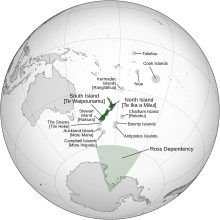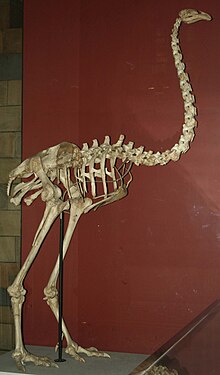 Global Information
Global InformationList of New Zealand species extinct in the Holocene information


This is a list of New Zealand species extinct in the Holocene that covers extinctions from the Holocene epoch, a geologic epoch that began about 11,650 years Before Present (about 9700 BCE)[a] and continues to the present day.[1] This epoch equates with the latter third of the Haweran Stage of the Wanganui epoch in the New Zealand geologic time scale.
The North Island and South Island are the two largest islands of New Zealand. Stewart Island is the largest of the smaller islands. New Zealand proper also includes outlying islands such as the Chatham Islands, Kermadec Islands, and New Zealand Subantarctic Islands. Only New Zealand proper is represented on this list, not the Realm of New Zealand. For extinctions in the associated states or dependent territory see the List of Oceanian animals extinct in the Holocene.
The islands of East Polynesia (including New Zealand, Hawaii, and Easter Island) were among the last habitable places on Earth colonised by humans.[2][3] The first settlers of New Zealand migrated from Polynesia and became the Māori people.[4] According to archeological and genetic research, the ancestors of the Māori arrived in New Zealand no earlier than about 1280 CE, with at least the main settlement period between about 1320 and 1350,[5][4] consistent with evidence based on genealogical traditions.[6][7] No credible evidence exists of pre-Māori settlement of New Zealand.[4] In 1642, the Dutch navigator Abel Tasman became the first European explorer known to visit New Zealand.[8] In 1769, British explorer James Cook became the first European to map New Zealand and communicate with the Māori.[9][10] From the late 18th century, the country was regularly visited by explorers and other sailors, missionaries, traders and adventurers. In 1840, the Treaty of Waitangi annexed New Zealand into the British Empire.[11][12][13] As a result of the influx of settlers, the population of Pākehā (European New Zealanders) grew explosively from fewer than 1,000 in 1831 to 500,000 by 1881.[14]
Numerous species have disappeared from New Zealand as part of the ongoing Holocene extinction, driven by human activity. Human contact, first by Polynesians and later by Europeans, had a significant impact on the environment. The arrival of the Māori resulted in animal extinctions due to deforestation[3] and hunting.[15] The Māori also brought two species of land mammals, Polynesian rats (Rattus exulans) and kurī, a breed of domestic dog (Canis lupus familiaris).[3][16] In pre-human times, bats were the only land mammals found in New Zealand.[17] Polynesian rats definitely contributed to extinctions,[3] and kurī might have contributed as well.[18][19] Like the Māori settlers centuries earlier, the European settlers hunted native animals and engaged in habitat destruction. They also introduced numerous invasive species.[20] A few examples are black rats (Rattus rattus) and brown rats (Rattus norvegicus),[21] domestic cats (Felis catus),[22] stoats (Mustela erminea),[23] and common brushtail possums (Trichosurus vulpecula).[24]
This list of extinct species only includes the indigenous biota of New Zealand, not domestic animals like the kurī.
Cite error: There are <ref group=lower-alpha> tags or {{efn}} templates on this page, but the references will not show without a {{reflist|group=lower-alpha}} template or {{notelist}} template (see the help page).
- ^ Walker, Mike; Johnsen, Sigfus; Rasmussen, Sune Olander; Popp, Trevor; Steffensen, Jorgen-Peder; Gibrard, Phil; Hoek, Wim; Lowe, John; Andrews, John; Bjo Rck, Svante; Cwynar, Les C.; Hughen, Konrad; Kersahw, Peter; Kromer, Bernd; Litt, Thomas; Lowe, David J.; Nakagawa, Takeshi; Newnham, Rewi; Schwander, Jakob (2009). "Formal definition and dating of the GSSP (Global Stratotype Section and Point) for the base of the Holocene using the Greenland NGRIP ice core, and selected auxiliary records" (PDF). Journal of Quaternary Science. 24 (1): 3–17. Bibcode:2009JQS....24....3W. doi:10.1002/jqs.1227. Archived (PDF) from the original on 4 November 2013. Retrieved 24 April 2022.
- ^ Wilmshurst, Janet M.; Hunt, Terry L.; Lipo, Carl P.; Anderson, Atholl J. (27 December 2010). "High-precision radiocarbon dating shows recent and rapid initial human colonization of East Polynesia". Proceedings of the National Academy of Sciences. 108 (5): 1815–1820. doi:10.1073/pnas.1015876108. ISSN 0027-8424. PMC 3033267. PMID 21187404.
- ^ a b c d Wilmshurst, Janet M.; Anderson, Atholl J.; Higham, Thomas F. G.; Worthy, Trevor H. (3 June 2008). "Dating the late prehistoric dispersal of Polynesians to New Zealand using the commensal Pacific rat". Proceedings of the National Academy of Sciences. 105 (22): 7676–7680. doi:10.1073/pnas.0801507105. ISSN 0027-8424. PMC 2409139. PMID 18523023.
- ^ a b c Walters, Richard; Buckley, Hallie; Jacomb, Chris; Matisoo-Smith, Elizabeth (7 October 2017). "Mass Migration and the Polynesian Settlement of New Zealand". Journal of World Prehistory. 30 (4): 351–376. doi:10.1007/s10963-017-9110-y.
- ^ Jacomb, C.; Holdaway, R. N.; Allentoft, M. E.; Bunce, M.; Oskam, C. L.; Walter, R.; Brooks, E. (2014). "High-precision dating and ancient DNA profiling of moa (Aves: Dinornithiformes) eggshell documents a complex feature at Wairau Bar and refines the chronology of New Zealand settlement by Polynesians" (PDF). Journal of Archaeological Science. 50: 24–30. doi:10.1016/j.jas.2014.05.023. ISSN 0305-4403.
- ^ Roberton, J. B. W. (1956). "Genealogies as a basis for Maori chronology". Journal of the Polynesian Society. 65 (1): 45–54.
- ^ Te Hurinui, Pei (1958). "Maori genealogies". Journal of the Polynesian Society. 67 (2): 162–165.
- ^ Wilson, John. "European discovery of New Zealand – Abel Tasman". Te Ara: The Encyclopedia of New Zealand. New Zealand. Retrieved 16 January 2010.
'On 13 December 1642 the Dutch sighted "a large land, uplifted high" – probably the Southern Alps ...'
- ^ Salmond, Anne (1991). Two worlds : first meetings between Māori and Europeans, 1642–1772. Auckland, N.Z.: Viking. ISBN 0-670-83298-7. OCLC 26545658.
- ^ Cook's Journal, 7 October 1769, National Library of Australia, http://southseas.nla.gov.au/journals/cook/17691007.html, visited 20120409
- ^ "Treaty events 1800–49 – Treaty timeline | NZHistory, New Zealand history online". nzhistory.govt.nz. Ministry for Culture and Heritage. Retrieved 26 July 2020.
- ^ Orange, Claudia (20 June 2012). "Treaty of Waitangi – Interpretations of the Treaty of Waitangi". Te Ara: The Encyclopedia of New Zealand. Retrieved 13 August 2019.
- ^ Orange, Claudia (20 June 2012). "Honouring the treaty – 1940 to 2000s". Te Ara: The Encyclopedia of New Zealand. Retrieved 26 July 2020.
- ^ James Belich, Making Peoples (1996) 278-80
- ^ Yirka, Bob; Phys.org. "DNA evidence suggests humans hunted moa to extinction". phys.org. Retrieved 20 May 2022.
- ^ Taonga, New Zealand Ministry for Culture and Heritage Te Manatu. "Kurī – Polynesian dogs". teara.govt.nz. Retrieved 20 May 2022.
- ^ "Bats/pekapeka". www.doc.govt.nz. Retrieved 20 May 2022.
- ^ "Gone to the dogs". New Zealand Geographic. Retrieved 20 May 2022.
- ^ "The dog is in the henhouse: did the kurī (Polynesian dog) have an impact on New Zealand's wildlife?". Sciblogs. Retrieved 20 May 2022.
- ^ "Animal pests and threats A – Z". www.doc.govt.nz. Retrieved 20 May 2022.
- ^ "Rats". www.doc.govt.nz. Retrieved 20 May 2022.
- ^ "Feral cats". www.doc.govt.nz. Retrieved 20 May 2022.
- ^ "Stoats". www.doc.govt.nz. Retrieved 20 May 2022.
- ^ "Possums". www.doc.govt.nz. Retrieved 20 May 2022.